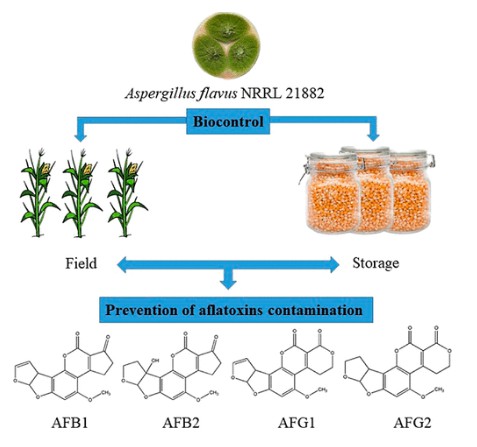Aflatoxins are secondary metabolites produced by Aspergillus flavus, A. parasiticus, A. nomius, and A. pseudotamarii. Aflatoxins are organic compounds with lower molecular weight, typically produced by fungal mycelia and accumulated in conidia and sclerotia. Aflatoxins contaminate many commercial value crops, including corn, oilseeds, rice, and nuts. Furthermore, aflatoxins cause considerable direct and indirect economic losses in many agricultural areas worldwide. Aflatoxin contamination in cereals can occur during the pre-harvest or post-harvest stages. High temperatures and humidity can stimulate fungal growth in fields and storage rooms. Aflatoxins are the most potent mutagenic, teratogenic, and carcinogenic compounds among mycotoxins, and long-term exposure can cause severe disease in humans, poultry, fish, and cattle. Several methodologies have been developed to control Aflatoxin contamination, yet they are usually expensive and unfriendly to the environment. Consequently, interest in using biocontrol agents has increased, as they are convenient, advanced, and environmentally friendly.
 Fig. 1. Non-aflatoxigenic aspergillus flavus: a promising biological control agent against aflatoxin contamination of corn. (Lavkor et al., 2023)
Fig. 1. Non-aflatoxigenic aspergillus flavus: a promising biological control agent against aflatoxin contamination of corn. (Lavkor et al., 2023)
With more than 100 countries now implementing or proposing regulations for aflatoxin levels in feed and food. Lifeasible is committed to developing simpler and more cost-effective biocontrol methods to control aflatoxin contamination in crops. We offer the most promising strategy for reducing pre-harvest contamination of aflatoxin crops by introducing non-aflatoxigenic Aspergillus flavus into the crop environment.
Our experts develop different techniques to discover non-aflatoxigenic Aspergillus flavus strains suitable for biocontrol. Some are based on phylogenetic characterization, while others are based on phenotypic characteristics such as mycelial size. In addition, we offer polymerase chain reaction (PCR)-based pyrophosphate sequencing methods to detect the genes responsible for aflatoxins production and to discover suitable biocontrol agents. We have successfully isolated several non-aflatoxin strains, including K49, F3W4, NRRL 58,974, NRRL 58,976, NRRL 58,988.
We can apply non-aflatoxigenic Aspergillus flavus strains to soil as infected barley, rice, wheat grain cultures or directly inoculate corn cobs by injection. Lifeasible has a rigorous control system for influencing factors affecting the efficacy of non-aflatoxigenic Aspergillus flavus strains for biocontrol, such as method of inoculation, inoculation rate, non-aflatoxigenic Aspergillus flavus strains application, abiotic factors (water activity and growth of non-aflatoxigenic Aspergillus flavus strains, temperature and growth of non-aflatoxigenic Aspergillus flavus strains), biotic factors, and physiological manipulation of non-aflatoxigenic Aspergillus flavus strains. We are based in the plant technology industry, providing professional and fast technical services and a mature platform to ensure the success of your project. The strong adaptability of short modification time makes biocontrol agents more competitive under critical conditions.
Lifeasible recognizes that each project has its unique challenges and goals, providing tailored biocontrol solutions for non-aflatoxigenic Aspergillus flavus. We aim to reduce aflatoxin contamination to the level required to accept contaminated food as fit for consumption. Contact us today to learn more about our services.
Reference